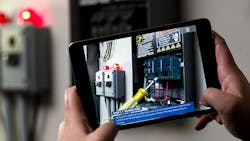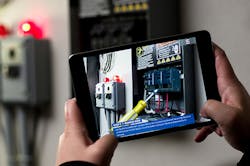Q&A: Why Should Engineers Care About Augmented Reality?
This file type includes high-resolution graphics and schematics when applicable.
Why should engineers care about augmented reality? I posed this question and more to Scope AR’s Scott Montgomerie. Scott is the co-founder and CTO of Scope AR, a vendor that’s making augmented reality a reality.
Wong: Why should engineers care about augmented reality (AR)?
Montgomerie: Augmented reality is really just a more interesting, intuitive way of interacting with a computer. For engineers, this means having a new powerful ability to visualize data or interact with others over a network in a much more natural way. In more concrete terms, this ability can have tremendous real-world benefits.
For starters, sending in experts from afar or constantly having to repair issues that were never fully resolved is time-consuming and expensive, often times creating downtime that costs in the millions. With complex tasks, phone (or even video) calls don't cut it, leaving lots of room for error and providing little opportunity for creating future efficiencies. However, with this more natural method of communication using augmented reality, field workers or those local to the issues can address a problem on equipment or machinery as if they had the knowledge of the engineer who created it. In the meantime, they can ensure they covered off on each step with backup systems all the while leaving a trail of analytics for future use.
Wong: How did you get into the field of AR?
Montgomerie: We actually founded Scope AR on the basis of a clear problem that we saw across all industries—as equipment becomes more complicated, technicians are stretched thin and don't always have the knowledge or resources they need to fix problems in a timely manner. This leaves an enormous gap in expertise, and organizations find themselves looking for a way to put their expert knowledge where they need it, when they need it. We realized that this problem required a new medium of communication, and we believed that augmented reality was the answer.
Once we set off on this new journey, an early project turned into a hugely disruptive achievement: We created the first true AR-glasses-based industrial training application. Demand in the wake of the project was so immediate and intense that Scope AR formed around that current vision to establish and maintain the gold standard in enterprise use cases with the power of augmented reality.
Wong: How has Scope AR addressed the challenge of AR's need for customization and the lack of standards in creating apps for use on an enterprise scale?
Montgomerie: Based on our experience in working with customers in various industries (aerospace, automotive, manufacturing, and energy), it was clear that our AR solutions were able to solve real problems by ensuring workers were able to complete tasks correctly. However, it was also clear that the bottleneck was in the ability to easily and rapidly create these instructions (or content), making it challenging for AR to truly be scalable and practical within industry. We realized that customized solutions for every project would not be cost-effective nor maintainable, so we created an instructional AR content authoring platform that has, for the first time, made AR for industry practical, quick, cost-effective, scalable, and most importantly, EASY.
Through the use of this platform, an organization’s SMEs can now rapidly create AR instructions or procedures, publish them to end users, and measure the impact in order to determine the effectiveness. This has, as a consequence, completely changed the perception of AR for industry.
Wong: What is WorkLink—Scope AR’s newest solution—and how does it work?
Montgomerie: WorkLink is the first smart instruction creation tool that enables non-technical staff to produce highly interactive AR instruction and training materials within a complete platform for data generation, feedback, and analytics. It cuts out the middleman (paying a consultant) and delivers the tools subject-matter experts need to build their workflow in AR themselves. There’s no coding required—it’s drag-and-drop animations, like Powerpoint.
This easy-to-use technology works by allowing users to take 3D models from any CAD document, like AutoCAD, and create animations, and add metadata, text, video, or images to build out a workflow with a step-by-step procedure. Using this converted CAD data, “smart” instructions are projected directly onto the task at hand, empowering end users to become their own expert without the requirement of extensive training. For an overview, watch this video:
Other really interesting applications are taking place in manufacturing. For example, with the power of AR, a worker can visually be guided step-by-step through assembly, noting where each part needs to be placed, as well as its orientation. This visually enhanced method allows a worker to better understand how to assemble something, thus significantly reducing errors. Couple that with WorkLink’s features for capturing a worker’s progress and screenshots of an assembly's state, and it’s a compelling value proposition for manufacturers.
Yet another application is in smart AR-enabled instruction manuals, which allow workers to see real-time instructions overlaid on top of equipment, allowing them to intuitively understand how to operate equipment or fix a problem.
WorkLink is also currently being used by a variety of customers ranging from energy and utilities to defense and consumer maintenance support.
Wong: What kind of hardware is needed to use WorkLink?
Montgomerie: It may seem that the majority of the media attention is around hands-free solutions such as glasses like ODG, HoloLens, and Meta. WorkLink is designed to support not only these types of wearables, but also common mobile devices that everyone has, including smartphones and tablets. In addition to supporting current devices, WorkLink is designed to be “future-proof” by supporting existing and all upcoming practical AR glasses.
Wong: How could WorkLink be merged with IoT devices?
Montgomerie: AR is a disruptive technology that will have significant impact on efficiency of organizations in support maintenance and field service. However, AR also needs to have a specific fit within an organization's technology infrastructure so that it can provide the most impact when it makes sense.
Integration with IoT devices is a good example of how various technologies will work together to create even more value. By capturing live data from a device, the appropriate AR experience (or instructions) can be initiated and associated with the specific readings from that device, and the data can be visualized in real time in a way never before possible. This ensures that the technician has the correct instructions based on the specific condition of that device. In turn, the analytics of the AR session (who accessed it, when, where from, and for how long) can all be integrated back into the organization’s ERP system for further added-value.
Wong: What other solutions does Scope AR provide?
Montgomerie: Our flagship product is Remote AR, the first AR live support video-calling platform. The augmented-reality-based remote assistance application provides users needing assistance with real-time expert support – anytime, anywhere. Think of it as FaceTime meets AR.
With the Remote AR app, an expert is able to connect with a technician via a voice/video call, see their video feed, and collaborate in real-time to resolve a problem. Using AR, the expert can “draw” on and add 3D graphics to the technician’s camera view to deliver knowledge and instruct their colleague on how to correctly perform a task. In other words, annotate in AR so that any graphics, text, or drawings “stick” to the part or area drawn on, even when the device/image is moving, which is inevitable.
For example, while viewing a live video stream of a machine undergoing maintenance, an expert could circle a bolt and tell the technician to remove it. Even as the technician moves around, the bolt would stay circled, allowing for an unprecedented level of interaction between the expert and technician.
The app is available on most Android and iOS smartphones and tablets, desktops for expert support, and select AR eyewear, including Epson Moverio, ODG R7, and any upcoming hardware including HoloLens.
Wong: Who are your users?
Montgomerie: Scope AR is currently working with some of the world’s leading global companies, including Boeing, NASA, Toyota, Lockheed Martin, Honeywell, Department of Defense (Australia), GE, Procter and Gamble, Cenovus, and CNAQ, among others.
Wong: When is it available and how much will it cost?
Montgomerie: Both Remote AR and WorkLink are currently available and priced based on the scope of use for each customer. Both are competitively priced and we’ve seen little-to-no push back from users saying it is anywhere near cost prohibitive.
Wong: What is the missing link in AR going mainstream?
Montgomerie: Currently, the missing link is awareness that AR can be easy, reliable, and practical. This ranges from the simplicity of our WorkLink software to the practicality of Remote AR for live support, as well as support for the future of AR hardware (glasses) and all of the devices that people currently have, such as their smartphones and tablets.
In addition to awareness, organizations need to ensure they invest in developing a roadmap where AR can support their challenges and accurately integrate their technology infrastructure.
About the Author
William G. Wong
Senior Content Director - Electronic Design and Microwaves & RF
I am Editor of Electronic Design focusing on embedded, software, and systems. As Senior Content Director, I also manage Microwaves & RF and I work with a great team of editors to provide engineers, programmers, developers and technical managers with interesting and useful articles and videos on a regular basis. Check out our free newsletters to see the latest content.
You can send press releases for new products for possible coverage on the website. I am also interested in receiving contributed articles for publishing on our website. Use our template and send to me along with a signed release form.
Check out my blog, AltEmbedded on Electronic Design, as well as his latest articles on this site that are listed below.
You can visit my social media via these links:
- AltEmbedded on Electronic Design
- Bill Wong on Facebook
- @AltEmbedded on Twitter
- Bill Wong on LinkedIn
I earned a Bachelor of Electrical Engineering at the Georgia Institute of Technology and a Masters in Computer Science from Rutgers University. I still do a bit of programming using everything from C and C++ to Rust and Ada/SPARK. I do a bit of PHP programming for Drupal websites. I have posted a few Drupal modules.
I still get a hand on software and electronic hardware. Some of this can be found on our Kit Close-Up video series. You can also see me on many of our TechXchange Talk videos. I am interested in a range of projects from robotics to artificial intelligence.
Scott Montgomerie
Co-founder, CEO, and CTO
Scott Montgomerie, serial entrepreneur and co-founder/CEO/CTO at Scope AR, has more than 15 years of consumer software and augmented-reality (AR) experience. He is one of the true pioneers in the industrial AR space and puts his industry expertise to work as the head of the company’s technology team. He is passionate about AR and how it can help organizations achieve their goals quickly, with significant cost savings. In fact, he has worked with virtually every commercial head-mounted display on the market and built his own head-mounted display.





